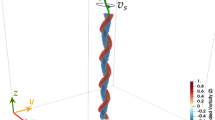Abstract
The response of a layer of superfluid mixture to an ac heat source,Q(t)=Q 0 exp(iωt), is determined. In the low-frequency regime, the temperature response at the heated side of a superfluid layer is essentially identical to that of an ordinary fluid having a thermal conductivity κeff and a thermal diffusion coefficient Γ 0 /2. Here κeff is the effective conductivity of Khalatnikov, and Γ 0 is the diffusion coefficient of Griffin. At much higher frequencies, the results are more complicated. The low-frequency regime is defined in terms of the second sound velocityu 2 by ω≪u 2 2 /Γ 0 . The ac response function is valuable in a number of ways. It can be used to obtain the system response to more complicated time-dependent variations inQ such as step changes inQ. A knowledge of the response function in the low-frequency regime provides a mechanism for directly determining the Kapitza resistance in mixtures. Finally, a knowledge of the response function provides an additional opportunity to test two-fluid hydrodynamics. Alternative tests of superfluid hydrodynamics are of particular interest in light of recent experiments that show anomalous values for κeff in the low3He concentration limit
Similar content being viewed by others
References
G. Ahlers, inThe Physics of Liquid and Solid Helium, K. H. Bennemann and J. B. Keterson, ed. (Wiley, New York, 1976).
M. Tanaka, A. Ikushima, and K. Kawasaki,Phys. Lett. 61A, 119 (1977).
D. Gestrich, M. Dingus, and H. Meyer,Phys. Lett. 99A, 331 (1983); M. Dingus, F. Zhong, and H. Meyer,Phys. Rev. Lett. 54, 2347 (1985); M. Dingus, F. Zhong, J. Tuttle, and H. Meyer,J. Low Temp. Phys. 65, 213 (1986).
F. Zhong, J. Tuttle, and H. Meyer, to be published.
T. C. P. Chui and J. A. Lipa,Phys. Rev. B 40, 4306 (1989).
E. D. Siggia,Phys. Rev. B. 15, 2830 (1977).
V. Dohm and R. Folk,Phys. Rev. B 28, 1332 (1983); R. Folk and A. Iro,Phys. Lett. 109A, 53 (1985).
A. Onuki,J. Low Temp. Phys. 53, 189 (1983).
I. M. Khalatnikov,Introduction to the Theory of Superfluidity (Benjamin, New York, 1965).
R. V. Duncan, G. Ahlers, and V. Steinberg,Phys. Rev. Lett. 58, 377 (1987).
R. Ferrell, to be published; private communication (1990).
R. P. Behringer and H. Meyer,J. Low Temp. Phys. 46, 435 (1982).
L. D. Landau and E. M. Lifshitz,Fluid Mechanics (Pergamon, Oxford, 1959).
R. V. Churchill, J. W. Brown, and R. F. Verhey,Complex Variables and Applications (McGraw-Hill, New York, 1976).
A. Griffin,Can. J. Phys. 47, 429 (1969).
D. S. Greywall and G. Ahlers,Phys. Rev. A 7, 2145 (1973).
R. Mehrotra and G. Ahlers,Phys. Rev. B 30, 5116 (1984).
F. Zhong, Ph.D. Thesis, Duke University, unpublished (1989).
R. P. Behringer,J. Low Temp. Phys. 62, 15 (1986).
Author information
Authors and Affiliations
Rights and permissions
About this article
Cite this article
Behringer, R.P. Thermal response of a3He-superfluid-4He mixture. J Low Temp Phys 81, 1–17 (1990). https://doi.org/10.1007/BF00683148
Received:
Issue Date:
DOI: https://doi.org/10.1007/BF00683148




